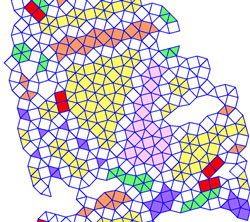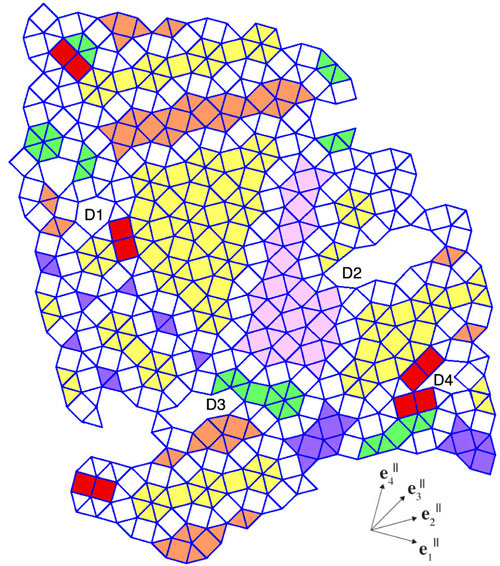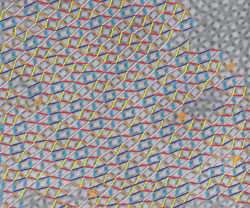Quasicrystalline Polymers
Quasicrystals are curious structures that aren’t completely random but also never quite repeat themselves the way crystal structures do. They have appeared in metals and a few other materials, but now a team reports in the 11 May Physical Review Letters that quasicrystals can also form in polymers. The spacing between the polymer structures is 100 times larger than between atoms, so it’s difficult to apply the quantum mechanical theories from previous quasicrystals to this new type. The larger size also means that these new structures could be used in devices called photonic crystals that manipulate the propagation of visible light.
The structure in normal crystals is periodic–the lattice looks the same if you move a certain distance in any direction. But quasicrystals, which were first seen in metallic alloys in the 1980s, aren’t periodic. They are reminiscent of geometric patterns called Penrose tilings, where different shapes, like two types of rhombus, are used in many orientations to completely “tile” over a plane. The tilings look like intricate wall-paper, but the design never repeats itself.
The ordered, aperiodic structure of quasicrystals is not limited to conventional solids, however. In 2004 a team in England found that an organic compound dissolved in a liquid forms quasicrystalline structures, and now Tomonari Dotera of Kyoto University and Yushu Matsushita of Nagoya University in Japan and their colleagues have added polymers–long-chain molecules–to the list. In earlier computer simulations and experiments, Dotera and coworkers studied mixes of three polymer types. When cast into several-micron-thick sheets, the three species segregate into many single-polymer regions that form two-dimensional geometric patterns in the film. These patterns are organized by star polymers–Y-shaped elements containing all three polymer types joined together at a single point. These special molecules appear at the points where three regions intersect. To analyze the geometry, the team “connects the dots” between all the instances of one polymer type.
One of the most complex geometries in these polymers involves triangles and squares in a ratio of 2 to 1. In the past, the team looked at deviations in this pattern and saw something that resembled a type of quasicrystal in which the triangle-to-square ratio is approximately 2.309. Dotera’s simulations suggested that adding more of one of the polymer ingredients would generate more triangles and distort the polymer pattern towards a quasicrystal. In their latest work, Dotera’s experimental collaborators have now synthesized the polymers according to his recipe. The team then mapped out the domains with transmission electron microscopy. Although the geometry was severely distorted in some regions, they found the ratio of triangles to squares was 2.305, in close agreement with the perfect quasicrystal. As a further demonstration, the researchers took x-ray diffraction images and found the 12-fold rotational symmetry expected for this type of quasicrystal.
The spatial extent of the polymer pattern is small, so it might be a mixture of misaligned crystal-like structures, rather than a true quasicrystal, says Christopher Henley of Cornell University. “But it’s much more clearly quasicrystalline than what was seen before” by this team.
According to Dotera, these polymer structures are of a size that could lead to new types of photonic crystals–structures that can manipulate light for possible future devices, such as optical chips that would use “light circuits” instead of electrons.
The large element size in polymer quasicrystals may also have theoretical implications, because the same quantum mechanical physics thought to explain the atom arrangement in metallic quasicrystals does not apply to large polymer molecules. Dotera believes there may be some deep, unifying principles that can explain quasicrystals of any size.
–Michael Schirber
Michael Schirber is a Corresponding Editor for Physics Magazine based in Lyon, France.







